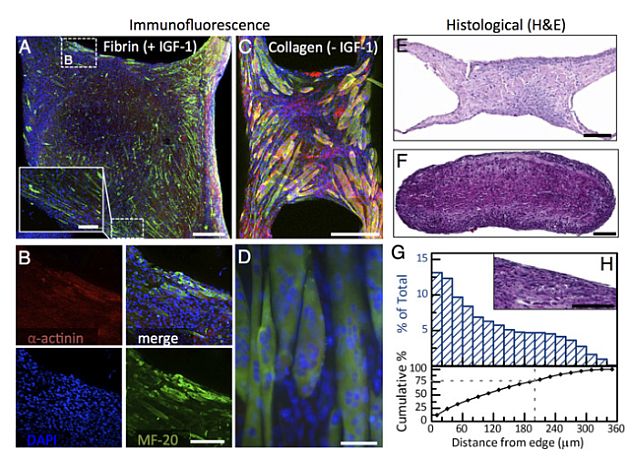- Home
- Science
- Science News
- Researchers Develop Muscle Powered Bio Bots That Can Walk on Demand
Researchers Develop Muscle-Powered Bio-Bots That Can Walk on Demand

Researchers, including one of Indian-origin, have developed a new generation of tiny walking biological robots powered by muscle cells.
Engineers at the University of Illinois at Urbana-Champaign developed the miniature 'bio-bots' powered by muscle cells and controlled with electrical pulses, giving researchers unprecedented command over their function.
"Biological actuation driven by cells is a fundamental need for any kind of biological machine you want to build," said study leader Rashid Bashir, Abel Bliss Professor and head of bioengineering at the university.
"We're trying to integrate these principles of engineering with biology in a way that can be used to design and develop biological machines and systems for environmental and medical applications," Bashir said.
Bashir's group has been a pioneer in designing and building bio-bots, less than a centimetre in size, made of a flexible 3D printed hydrogels and living cells.
Previously, the group demonstrated bio-bots that "walk" on their own, powered by beating heart cells from rats. However, heart cells constantly contract, denying researchers control over the bot's motion. This makes it difficult to use heart cells to engineer a bio-bot that can be turned on and off, sped up or slowed down.
The new bio-bots are powered by a strip of skeletal muscle cells that can be triggered by an electric pulse.
This gives the researchers a simple way to control the bio-bots and opens the possibilities for other forward design principles, so engineers can customise bio-bots for specific applications.
The design is inspired by the muscle-tendon-bone complex found in nature. There is a backbone of 3D-printed hydrogel, strong enough to give the bio-bot structure but flexible enough to bend like a joint.
Two posts serve to anchor a strip of muscle to the backbone, like tendons attach muscle to bone, but the posts also act as feet for the bio-bot. A bot's speed can be controlled by adjusting the frequency of the electric pulses. A higher frequency causes the muscle to contract faster, thus speeding up the bio-bot's progress.
The researchers will work to gain even greater control over the bio-bots' motion, like integrating neurons so the bio-bots can be steered in different directions with light or chemical gradients.
"The goal of 'building with biology' is not a new one - tissue engineering researchers have been working for many years to reverse engineer native tissue and organs, and this is very promising for medical applications," said graduate student Ritu Raman, co-first author of the paper.
The work is published in Proceedings of the National Academy of Science.
Catch the latest from the Consumer Electronics Show on Gadgets 360, at our CES 2026 hub.
- Samsung Galaxy Unpacked 2025
- ChatGPT
- Redmi Note 14 Pro+
- iPhone 16
- Apple Vision Pro
- Oneplus 12
- OnePlus Nord CE 3 Lite 5G
- iPhone 13
- Xiaomi 14 Pro
- Oppo Find N3
- Tecno Spark Go (2023)
- Realme V30
- Best Phones Under 25000
- Samsung Galaxy S24 Series
- Cryptocurrency
- iQoo 12
- Samsung Galaxy S24 Ultra
- Giottus
- Samsung Galaxy Z Flip 5
- Apple 'Scary Fast'
- Housefull 5
- GoPro Hero 12 Black Review
- Invincible Season 2
- JioGlass
- HD Ready TV
- Laptop Under 50000
- Smartwatch Under 10000
- Latest Mobile Phones
- Compare Phones
- OPPO A6 Pro 5G
- OPPO A6s
- OPPO Reno 15 Pro Max
- Honor Win RT
- Honor Win
- Xiaomi 17 Ultra Leica Edition
- Xiaomi 17 Ultra
- Huawei Nova 15
- Asus ProArt P16
- MacBook Pro 14-inch (M5, 2025)
- OPPO Pad Air 5
- Huawei MatePad 11.5 (2026)
- Xiaomi Watch 5
- Huawei Watch 10th Anniversary Edition
- Acerpure Nitro Z Series 100-inch QLED TV
- Samsung 43 Inch LED Ultra HD (4K) Smart TV (UA43UE81AFULXL)
- Asus ROG Ally
- Nintendo Switch Lite
- Haier 1.6 Ton 5 Star Inverter Split AC (HSU19G-MZAID5BN-INV)
- Haier 1.6 Ton 5 Star Inverter Split AC (HSU19G-MZAIM5BN-INV)












